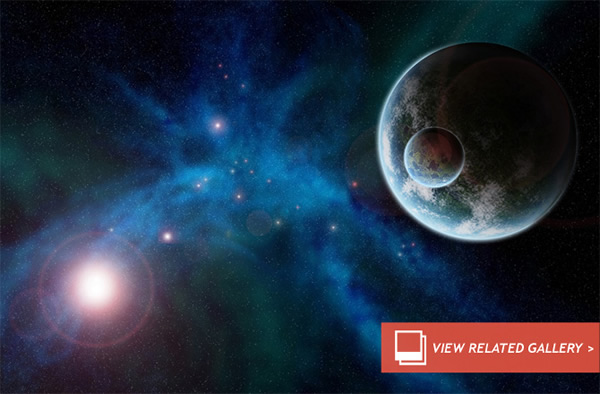Kraft to NASA: Get Out of this Solar System
Kraft to NASA: Get Out of this Solar System
During a powerful interview with the Houston Chronicle this week, NASA’s first manned spaceflight director Chris Kraft gave his unabashed opinion about the current state of NASA and its future plans.
Kraft oversaw NASA’s first manned spaceflight missions, from Alan Shepard’s Freedom 7 suborbital flight (1961) to Ed White’s Gemini 4 orbital spacewalk (1965). He was also a senior Apollo Program manager and planner. In short, Kraft was there at the birth of NASA and set the agency on what should have been a bright beginning for humans in space. As rightfully stated by the Chronicle’s Eric Berger, “Kraft is a legend, and therefore not afraid to speak his mind.”
Sadly, as the 89 year old retired NASA engineer expressed in the interview, he’s disappointed with NASA’s manned progress in space, calling the situation a “tragedy.”
For starters, Kraft is highly critical of the next NASA rocket, the Space Launch System (SLS): “The necessity of having a big rocket is not justifiable. It’s not justifiable from a cost point of view, and it’s not justifiable from a mission plan point of view. It just doesn’t make good sense.”
The key concern is that SLS costs will overrun and to launch the rocket will become prohibitively expensive for a cash-strapped NASA. The agency is taking two steps back with this strategy — it’s unlikely that more than one SLS launch per year will be possible.
Rather than building a monster rocket, why not use smaller designs, while seeking international cooperation, to launch smaller payloads into orbit and then construct the larger components in space? This is after all a sustainable model that can use current tried and tested technology. “What’s so magic about this being able to lift 120 tons? Why can’t you use what you’ve got and put your vehicles into space in pieces, like you did with the space station?” he asked.
“Whether you want to go to the moon or Mars, you’re going to have to do something in Earth orbit, or maybe lunar orbit, with an assembly capability, a fuel depot capability and the capability to have people operating there sort of as a Cape Canaveral in the sky.”
The flagship mission that the SLS will initially launch is the much-hyped asteroid retrieval jaunt some time in the mid-2020′s, perhaps. After sending a robotic “asteroid bagging” spacecraft to hunt down a small space rock only a couple of meters wide, it will then be steered into a lunar parking orbit. Then the newly-minted Orion Multi-Purpose Crew Vehicle (MPCV) will be launched (atop the massive SLS) with a team of astronauts to the parked asteroid where they can chisel some asteroid samples and bring them back in a baggy to Earth.
The details are a little more complex than that, but NASA is basically proposing a mission where astronauts aren’t required. If we’ve gone so far as developing an advanced robotic probe that can chase down, capture, de-spin and tug into a lunar parking orbit, surely NASA can develop a sample return robot too (that has, after all, already been done). From this logic, if astronauts aren’t needed, why develop a heavy-lift rocket for the impending asteroid retrieval mission at all?
In regard to the asteroid retrieval plan, Kraft continues: “Congress is already saying what NASA is doing is wrong. They’re saying they don’t like the asteroid mission. Most in Congress want to see NASA go back to the moon.” The scientific reasons for a return to the moon far outweigh the science that can be done on a captured asteroid and, as pointed out by Kraft, the lunar surface is a resource that can be utilized for practical purposes, such as building a vast solar array.
As for the continuously deferred plan to send humans to Mars, Kraft is not a fan. “Pretty much everything we need to do on Mars can be done robotically,” he said. “We’ve already got robots there. By the time we get the capability to send humans to Mars, it might be that robots are smarter than humans anyway. I’m serious.”
Kraft headed NASA at a time when the agency was tasked with doing bold, and seemingly impossible, things in space. Apart from a brief foray on the moon’s surface, NASA hasn’t sent an astronaut beyond Earth orbit. NASA’s manned space program is being strangled by budget cuts, has a swelling infrastructure and politics keep setting unrealistic goals for all the wrong reasons. What would revitalize NASA and give humanity a real boost in space?
“… if you really want to go somewhere, get out of this solar system,” said Kraft. “Eventually that’s what you’re going to have to do. I don’t know how to do that, but we’ll figure out how to do it one day.” (Emphasis added)
As repeatedly argued by interstellar spaceflight advocates, this is exactly what NASA and the international community as a whole should be shooting for. Having a long-term (possibly multi-generational) interstellar goal won’t only bolster our space transportation and resource acquisition capabilities in our solar system, it would fundamentally change our perspective on our place in the galaxy. As Kraft’s early human spaceflight era taught the world, aiming for a seemingly “impossible” goal can have transformative effects on terrestrial technologies, education and the human spirit.
Aiming for interstellar space could supercharge our race.(Sep 6, 2013 04:53 AM ET // by Ian O'Neill)












